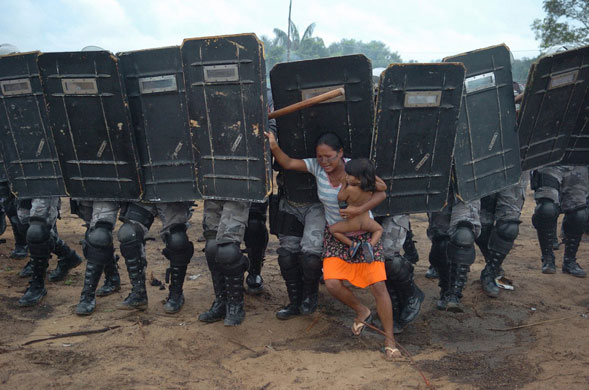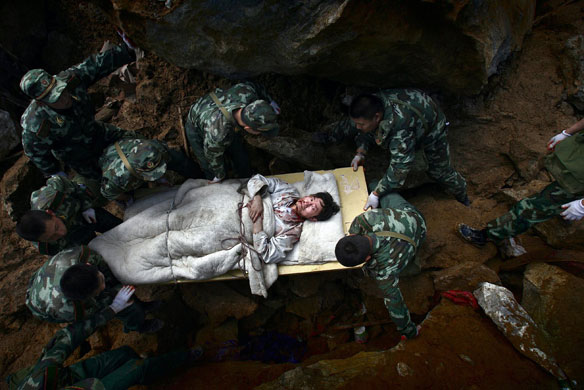My focal photographer choice was partially by chance because I wanted to find out who took the "Saigon Execution" photograph. Little did I know, that it was taken by a well respected photojournalist named
Eddie Adams. I wanted to find a photographer who had a similar work as Adams and it was quite difficult looking for one. However, to the best of my abilities,
Stacy Pearsall was the closest photographer that emulated Adams.
Background
Adams became interested in photography during his teenage years. Doing portrait and wedding photography, he decided to take his passion elsewhere. He enlisted in the United States Marine Corps and spent three years as a combat photographer during the Korean War. Noted for his celebrity portraits and coverage of 13 wars (including the Korean War), Adams was a Pulitzer Prize winning American photographer and photojournalist, known for the photograph "Saigon Execution" (Figure 1).
I personally believe that, combat photography is the most dangerous type of job for photographers. They are soldiers armed by photographic equipment, instead of firearms and they are photographers who are trained for war. One can say that it is profession which is bittersweet. Combat photographers are placed in the most difficult situations, most of the times being in the middle of a gunfire, but they are able to take the most controversial, yet beautiful pictures during wartimes.
Figure 1 - Saigon Execution: A picture of General Nguyễn Ngọc Loan executing Nguyễn Văn Lém on February 1, 1968 in the Vietnam War.
This picture caused a lot of controversy which Adams did not mean to cause. For those who do not know the real story or meaning behind this picture, it is obvious to conclude the inhumane act that General Loan showed when this picture was taken. However, that was not the case. Lém was actually a Viet Cong lieutenant prisoner who murdered a South Vietnamese colonel, his wife and their six children ("Newseum"). After this photograph was published, Adams said "Photographs, you know, they're half-truths." He apologized to General Loan, in person, for the humility and irreparable damage it caused to the General's honour and Adams later acknowledged him as a "hero" of "just cause".
Stacy Pearsall
Pearsall's military background is associated with the long line of military men and women in her family. Her great-grandfather was a Marine in WWI, her grandfather served in WWII and her father was a Navy-man in the Vietnam War era. She joined the Combat Camera Squadron in January of 2002 and was taught by other competitive photographers. Four tours later, she has awarded two Photographer of the Year (2003 and 2007) by the NPPA, and she is one of only two women who has won it since 1967. She was medically retired after being injured in 2003 and 2007 while serving in Iraq (Pearsall).
I found Pearsall's work enticing and captivating, and I feel as if I am where she was when she took the picture. Although it does not have the black and white affect that are found in most of Adams' photographs, it still shows the wonderful point of views that a combat photographer sees. I would not classify Pearsall only as a photojournalist because she also some art photography which she has some of her comrades posed in certain positions, and there are also some pictures which have been clearly edited.
BROTHERHOOD SERIES
Figure 2 - U.S. Army Spec. William McGrath and Spec. Daniel Brothers launch a grenade toward enemy fighters after coming under fire in Buhriz, Iraq, on Feb. 15, 2007
Figure 3 - U.S. Air Force Airmen transfer wounded military personnel form an ambulance to a C-17 Globemaster III aircraft in Baghdad, Iraq, on June 22, 2003
The 'Brotherhood' series definitely sends an impact to those that are away from home, those that are away from their loves ones and those who are not sure if they are coming home. Figure 2 is a perfect picture when it comes to support. Just having the focus on the two soldiers shows that they are brothers in arms. War overseas can sometimes be hard for the men and women serving in the army. They have no one to rely on but each other in times of happiness, being homesick and pain. So not only are they brothers in arms, but they are also there for emotional support. Figure 3 shows a picture of relief. The perfect centered backdrop of the sunset shows that at the end of the day, regardless if the soldier is wounded or not, they are always there for each other. In addition, I also think if Figure 3 did not have a caption, a viewer could conclude that a soldier has died in action. It goes to show that captions help give meaning to the photograph.
OPERATION IRAQ FREEDOM SERIES
Figure 4 - While searching for al-Qaeda and Ansar al-Sunna forces, members of the Multi-Iraqi Transitional Team, 4th Battalion, 2nd Brigade, 5th Division, question the locals during Operation Orange Justice in Buhriz, Iraq, on Feb. 10, 2007
Figure 5 - An Iraqi soldier from the 2nd Battalion, 2nd Brigade, 5th Division, tries to kick open a gate during a cordon and search for insurgence and weapons caches in Chubinait, Iraq, on Feb. 3, 2007
Figure 6 - A local Iraqi woman cries after her husband is detained during Operation Brown Hawk in Tahrir, Iraq on Feb 27, 2007.
The 'Operation Iraq Freedom' series is one of Pearsall's best work. It shows the struggles of Iraq during the war and how its people is being affected. Personally, I think that it is hard for Iraqi soldiers to hunt down their own people and it pains them to see their own people suffering because of the war. They should be united as a nation, however, due to conflicting beliefs, they are divided. Figures 4 shows innocence in terms of the people being interrogated about the location of people they are associated with. You can see the full cooperation of the gentleman on the right. I believe that he's being cooperative for the sake of his family. Figure 5 captures an action moment of an Iraqi soldier breaking down a door. I think that this picture was taking at the right place at the right time because it portrays that a cordon and search operation is no joke and should not be taken lightly. The black and white effect in Figure 6 definitely captures the pain and sadness that the Iraqi woman is going through as she watches her husband being detained. I believe that Iraqi women who are involved with men who are detained are heartbroken not because of the actions that their husbands took part in, but because they may never see their husbands again.
Sources
"1969 Spot News: Edward Adams, The Associated
Press." Newseum. Newseum, n.d. Web. 29 Nov 2011.
<http://www.newseum.org/exhibits-and-theaters/permanent-exhibits/pulitzer/videos/1969-spot-news-edward-adams--the-associated-press.html>
"Eddie Adams: Biography." N.p., 2004. Web. 29
Nov 2011. <http://www.answers.com/topic/eddie-adams-1>
Goldberg, Jonah. "There are Tears in My Eyes-Eddie
Adams & the Most Famous Photo of the Vietnam War." National
Review Online. N.p., 1999. Web. 29 Nov 2011. <http://www.nationalreview.com/articles/204511/there-are-tears-my-eyes/jonah-goldberg>
Pearsall, Stacy. N.p., n.d. Web. 29 Nov 2011.
<http://stacypearsall.photoshelter.com/>









































